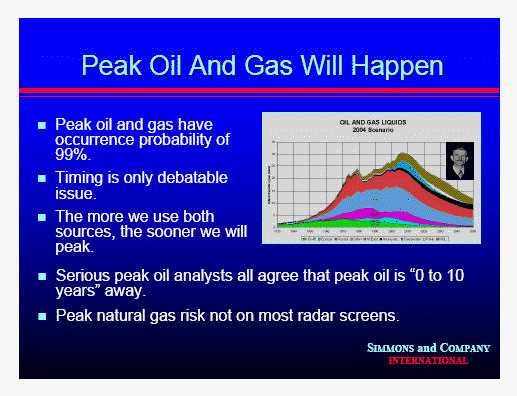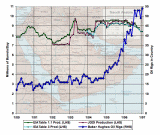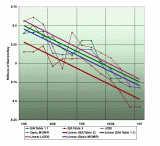Svensk doktorsavhandling om Peak Oil
Fredrik Robelius har (antar jag) arbetat under Kjell Aleklett och han kommer att försvara sin avhandling nu på fredag den 30/3 i Uppsala och opponent blir ingen mindre än Robert Hirsch.
Titeln på avhandlingen är "Giant Oil Fields - The Highway to Oil: Giant Oil Fields and their Importance for Future Oil Production ".
Kortfattad info om disputationen finns på Uppsala Universitets sida.
Sammanfattning på engelska: (Missa inte slutet!)
"Since the 1950s, oil has been the dominant source of energy in the world. The cheap supply of oil has been the engine for economic growth in the western world. Since future oil demand is expected to increase, the question to what extent future production will be available is important.
The belief in a soon peak production of oil is fueled by increasing oil prices. However, the reliability of the oil price as a single parameter can be questioned, as earlier times of high prices have occurred without having anything to do with a lack of oil. Instead, giant oil fields, the largest oil fields in the world, can be used as a parameter.
A giant oil field contains at least 500 million barrels of recoverable oil. Only 507, or 1 % of the total number of fields, are giants. Their contribution is striking: over 60 % of the 2005 production and about 65 % of the global ultimate recoverable reserve (URR).
However, giant fields are something of the past since a majority of the largest giant fields are over 50 years old and the discovery trend of less giant fields with smaller volumes is clear. A large number of the largest giant fields are found in the countries surrounding the Persian Gulf.
The domination of giant fields in global oil production confirms a concept where they govern future production. A model, based on past annual production and URR, has been developed to forecast future production from giant fields. The results, in combination with forecasts on new field developments, heavy oil and oil sand, are used to predict future oil production.
In all scenarios, peak oil occurs at about the same time as the giant fields peak. The worst-case scenario sees a peak in 2008 and the best-case scenario, following a 1.4 % demand growth, peaks in 2018."
Här kan du hämta hela avhandlingen som pdf (3,7MB).
Tack Olle, för tipset.
C-uppsats: Med brödfödan som drivkraft
Jacob Nordangård, geograf vid Linköpings Universitet har skrivit uppsatsen vars sammanfattning lyder:
”Av två anledningar anses det som mycket viktigt att bryta beroendet av olja, naturgas och kol. Den första anledningen är de uppmärksammade klimatförändringarna. Förbränning av fossila bränslen anges idag som huvudorsak till växthuseffekten. Den andra mindre uppmärksammade orsaken är att oljan och naturgasen snart inte räcker till för att föda en allt energihungrigare värld. Utvinningen ser dessutom ut att ha nåt sin kulmen. Efter denna kommer en oundviklig produktionsnedgång. Med det stora beroendet som finns av oljan inom i stort sett alla sektorer är det ytterst viktigt att hitta andra alternativ. Speciellt gäller detta inom transportområdet. Förhoppningen står idag till ”gröna” drivmedel som etanol och biodiesel. IEA (International Energy Agency) har uppmanat de västerländska nationerna att satsa stort på biobränslen. I denna studie görs en analys av de förutsättningar som finns att bygga ut produktionen av denna i USA, Brasilien och Malaysia/Indonesien. Syftet har varit att ta reda på om det är möjligt att göra detta utan att inkräkta på andra näringar, inte skada miljön samt vara oberoende av fossil energi? Den bakomliggande teorin är att detta inte låter sig göras i den omfattning som krävs för att bibehålla de nuvarande samhällsstrukturerna. Detta visar sig också stämma med de uppgifter som står till buds. Endast en fraktion av det nuvarande drivmedelsbehovet går att försörja med biodrivmedel om det inte ska uppstå en allvarlig konkurrens om odlingsmarken eller orsaka stora ekologiska skador.”
Här kan man hämta hela uppsatsen.
Peak Oil Review No. 13
Innehåll:
1. Stockpiles and fear
2. Ottawa, the tar sands, and a car efficiency plan
3. Coal
4. Quote of the week:"That could be a problem." Jeff Combs, president of Ux Consulting Company LLC, said the administration has not come to grips with the looming shortfall in enriched uranium, even as it encourages utilities to construct reactors.
5. Energy briefs (14 st)
Commentary #1: The Elasticity of Oil Production and Consumption
Citat:
"Conclusion
As oil and natural gas deplete, suppliers will attempt to charge as much as the market will bear. That – in turn – will force demand destruction as higher prices and availability curb consumption. Unfortunately, since American oil demand per household has been relatively inelastic since 1982, demand destruction can only occur if the economy is forced into a recession, and/or Americans make substantial changes to their lifestyle.
Neither option will be pleasant.
Peak Oil Review ges ut av ASPO-USA och en gratis prenumeration fås om man skriver till peakoilreview@aspo-usa.com
ASPO Nyhetsbrev Mars
Innehåll:
802. Regional Assessment – MIDDLE EAST GULF
803. Post-Peak Agriculture
804. Optimism in Britain
805. ASPO6 & Apres-Pic
806. Further Update of the Depletion Model
807. ASPO in Japan
808. The Buffer of Storage
809. Signs of the times
Här kan du hämta nyhetsbrevet(pdf). Finns även i html.
Kommande oljeprojekt
Chris Skrebowski sammanställer regelbundet alla större projekt inom oljesektorn som skulle kunna ersätta de fält som passerar sitt produktionsmax och börjar minska. Det handlar med andra ord om när Peak Oil kommer att infalla, snart eller senare?
Den senaste sammanställningen finns att läsa i februarinumret av Petroleum Review.
"It is only possible to draw two conclusions from this latest megaprojects analysis. First, data on production, project performance and depletion rates is wholly unsatisfactory, particularly for the Opec producers. Second, the large volumes of new capacity being added between 2007 and 2012 may not translate into the sort of increased production flows the world economy needs to underpin economic growth."
Hämta artikeln med tabeller som PDF från brittiska ODAC.
Nya presentationer av Simmons
Matthew Simmons gjorde sig ett namn med boken Twilight in the Desert. Han är mycket aktiv föreläsare och har nu lagt ut material från 4 presentationer han höll under Januari/Februari. PowerPointbilderna är delvis desamma men med olika vinkel beroende på åhörarna.

Läs mer hos Simmons & Company International.
Mer om Saudi
Stuart Staniford har förmodligen fått en del frågor kring artikeln nedan så han skrev en utförligare förklaring till varför han drar slutsatsen att Saudiarabien får kämpa för att hålla uppe produktionen. Dessutom har han inte fått någon att nappa på 10 000-dollarsvadet så han höjer till 20 0000!
Detta är den inledande sammanfattningen:
- "Saudi production can be divided into two eras. In the first, prior to the third quarter of 2004, KSA had spare capacity and acted as the swing producer, making large voluntary changes in their production to stabilize the market. During this era, all major features of the production graph can be well understood based on demand side needs.
- Since late 2004, KSA have entered a new era where they cannot raise production in response to demand side needs, and instead the major features of the production curve correspond to supply side events.
- During 2002, KSA was increasing production to accomodate increasing demand as the world recovered from the recession of 2001.
- In 2003, there was a major spike in oil production immediately preceding and during the US invasion of Iraq: this was a voluntary action to stabilize oil prices in the face of the loss of Iraqi production. As combat wound down, and Iraqi oil production resumed, Saudi production declined back to levels slightly higher than before the war.
- Oil prices increased due to increasing US, Chinese, etc demand in the strong economy of 2003 and early 2004. Once it became clear that oil prices had risen pronouncedly above OPECs desired $22-$28 price band, KSA initiated a large voluntary increase in production in the spring of 2004 in an attempt to bring prices back into the band. They were not able to raise production by more than 1 million barrels per day (mbpd), however, and this was not sufficient to stabilize prices, which have never returned to the price band. The band was abandoned a year later.
- After continuing to increase production very slightly for several more months, Saudi production began to decline in late 2004. This was only arrested by the arrival of the first KSA oil "megaproject", the 800 thousand barrel/day (kbpd) output from the combined Qatif/Abu Sa'fah fields (690kbpd of new crude and condensate production). This 690kbpd arrested declines during early 2005, but never sufficed to raise production above the peak achieved in 2004. There was no sign of Saudi increases in production in response to the high prices of 2005 and since, nor to the loss of production from the Gulf of Mexico hurricanes in 2005.
- Production began to decline again in 2005, and at greater rates through 2006. This was only arrested briefly by the arrival of oil from the 300kbpd Haradh III development in late spring of 2006.
- If these trends were to continue, Saudi oil production would halve over the next five years. However, it seems more likely that KSA will find ways to bring smaller fields on line and start to mitigate the decline within this time period.
Just nu har
artikeln 308 kommentarer. Många är berömmande och påstår att det är bland
det bästa de har läst inom området.
Ett sista citat:
"For
those of you doomers keen to see this as the end of civilization as we know
it, it's going to take more than this for me to join you. While it's
certainly worrying, we need to keep some perspective: 8% of Saudi production
is 1% of global production, and as long as global declines are less than a
few percent a year they are well within society's proven capacity to adapt.
Probably the biggest potential issue is the political stability of the
Kingdom of Saudi Arabia once this news becomes clear to everyone".
Läs mer
i: A Nosedive Into the Desert.
Peak Oil Review No. 10
Innehåll:
1. Stockpiles and stock markets
2. Saudi production
3. Confrontation at Doha
4. Pollution time bomb
5. Quotes of the week
Sadad al Husseini, former head of exploration and production for Saudi Aramco:
"The huge oil and gas reservoirs in the [Middle East] can become only more peculiar and complex with time and maturity. They are already generating a wide range of technical challenges that are often similar to the challenges encountered elsewhere in the world but on a scale that dwarfs previous experiences."
"The worst thing that could happen is to confuse ourselves and the public with too much spin about unlimited energy supplies at cheap prices, alternative fuels on a global scale, or energy independence in a matter of years. That kind of thinking simply dilutes our focus, defers the tough solutions that are needed today, and sets us all up for more future shocks and economic disruptions."
6. Energy Briefs
Commentary : More ‘smoke and mirrors’ in Australia
Peak Oil Review ges ut av ASPO-USA och en gratis prenumeration fås om man skriver till peakoilreview@aspo-usa.com
Saudiarabien faller
The OilDrum har några Excel-människor och en av dem är Stuart Staniford. Han har skrivit tidigare om att Saudiarabiens oljeproduktion verkade svajig. Nu har han tagit sig en ny titt och den här gången säger han sig vara säker.

Den första bilden visar oljeproduktionen enligt några olika bedömare (Saudisk oljeproduktion är en statshemlighet). Den blå linjen visar antalet oljeriggar på saudisk mark och vatten. Den snabbaste tolkningen är kanske att landet borrar efter olja för att man vill förstärka sin överkapacitet, men Staniford tror att det snarare handlar om att hålla uppe nuvarande produktion
Den andra bilden visar hur de fyra källornas data visar samma tendens. Ett tydligt fall trots
 den
puckel som uppträder i mitten av förra året och som Staniford gissar är
projektet Haradh III som skall ge c:a 300 000 fat/dag.
den
puckel som uppträder i mitten av förra året och som Staniford gissar är
projektet Haradh III som skall ge c:a 300 000 fat/dag. Detta är hans slutsatser:
Han avslutar med erbjudandet att slå vad om 10 000 dollar om att Saudiarabien aldrig kommer att producera 10,7 miljoner fat/dag eller mer (olja+kondensat). Saudierna själva hävdar att de tänker bygga ut sin kapacitet till 12 miljoner fat/dag. Båda kommer inte att få rätt.
Fler grafer, siffror och just nu 381 kommentarer på Saudi Arabian oil declines 8% in 2006.